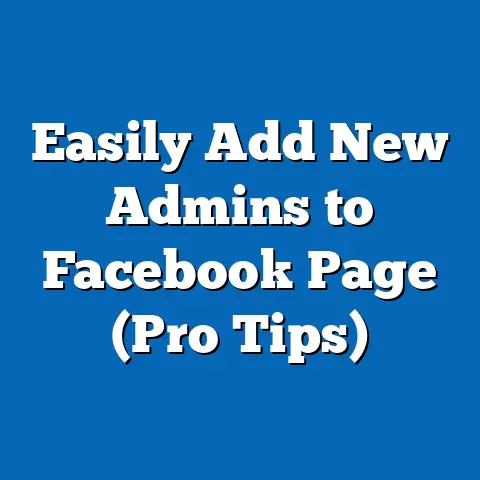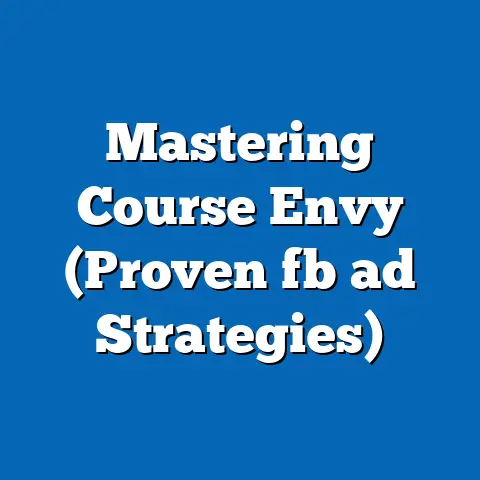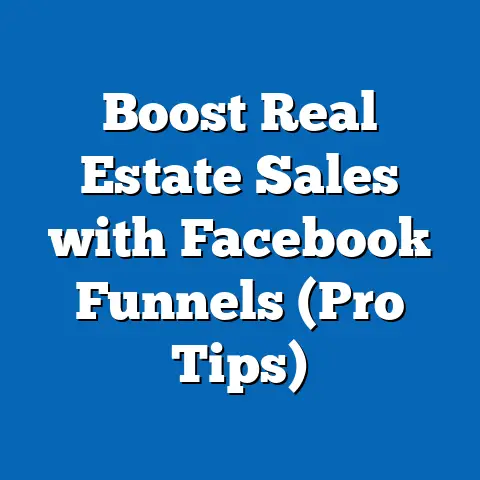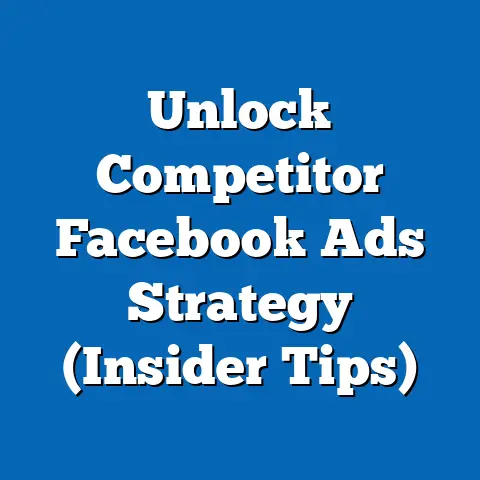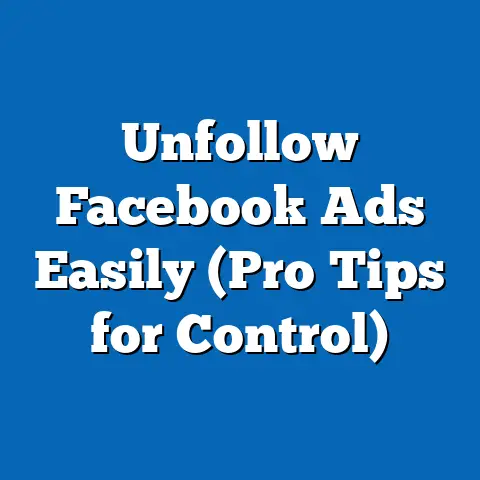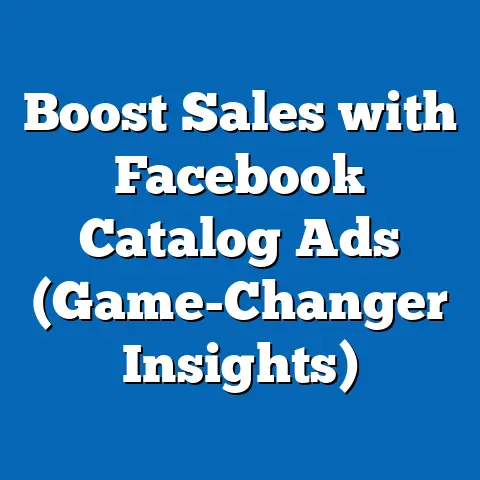Unlock Facebook Ads Rates (Expert Insights Revealed)
Imagine you’re holding a treasure map. It’s filled with symbols, cryptic directions, and promises of untold riches. But without understanding the map’s language, the terrain it describes, and the challenges along the way, you’re unlikely to find the treasure. That’s how I see navigating Facebook Ads rates – it’s a complex journey where understanding the nuances can lead to incredible results, while missteps can leave you lost and broke.
In this article, I’m going to be your guide, sharing expert insights to help you decipher the “treasure map” of Facebook Ads rates and unlock the full potential of your campaigns. I’ll break down the components of ad costs, explore the factors that influence them, and provide actionable strategies to optimize your spending and maximize your ROI. Get ready to embark on a journey to master Facebook advertising and make your budget work smarter, not harder.
The Landscape of Facebook Advertising
Facebook isn’t just a social media platform; it’s a colossal digital advertising arena. With billions of active users, it offers unparalleled reach and targeting capabilities, making it a cornerstone of modern marketing strategies.
According to Statista, Facebook’s advertising revenue reached over $116 billion in 2023, a testament to its effectiveness and the reliance businesses place on it. From small startups to global corporations, companies across all industries leverage Facebook Ads to connect with their target audiences, drive brand awareness, generate leads, and boost sales.
But with great power comes great complexity. The sheer scale and sophistication of Facebook’s advertising platform mean that understanding ad rates is crucial for success. Simply throwing money at ads and hoping for the best is a recipe for disaster. Instead, businesses need to grasp the fundamental principles of how Facebook Ads rates work and how to optimize their campaigns to achieve the best possible results.
Ad rates directly impact your bottom line. The higher your costs, the lower your ROI. This makes it essential to understand the factors that influence these rates and learn how to control them. Whether you’re a seasoned marketer or just starting out, mastering Facebook Ads rates is a key skill for thriving in today’s competitive digital landscape.
Key Takeaway: Facebook Ads are a powerful tool, but understanding ad rates is essential for maximizing ROI. Treat your ad budget like an investment and learn how to manage it effectively.
Understanding Facebook Ads Rates
Before we dive into the factors that influence Facebook Ads rates, let’s define the key metrics you need to know:
-
Cost Per Click (CPC): This is the amount you pay each time someone clicks on your ad. CPC is a direct measure of how engaging your ad is and how well it resonates with your target audience. A lower CPC indicates that your ad is relevant and compelling, while a higher CPC suggests that you need to refine your targeting or improve your ad creative.
-
Cost Per Mille (CPM): CPM, also known as Cost Per Thousand Impressions, is the amount you pay for every 1,000 times your ad is shown. CPM is particularly relevant for campaigns focused on brand awareness, where the goal is to get your message in front of as many people as possible. A lower CPM means you’re reaching a larger audience for the same budget.
-
Cost Per Action (CPA): CPA is the amount you pay for each specific action a user takes, such as making a purchase, filling out a form, or downloading an app. CPA is the most direct measure of ROI, as it directly ties your ad spend to specific business outcomes.
Cost Per Click (CPC): This is the amount you pay each time someone clicks on your ad. CPC is a direct measure of how engaging your ad is and how well it resonates with your target audience. A lower CPC indicates that your ad is relevant and compelling, while a higher CPC suggests that you need to refine your targeting or improve your ad creative.
Cost Per Mille (CPM): CPM, also known as Cost Per Thousand Impressions, is the amount you pay for every 1,000 times your ad is shown. CPM is particularly relevant for campaigns focused on brand awareness, where the goal is to get your message in front of as many people as possible. A lower CPM means you’re reaching a larger audience for the same budget.
Cost Per Action (CPA): CPA is the amount you pay for each specific action a user takes, such as making a purchase, filling out a form, or downloading an app. CPA is the most direct measure of ROI, as it directly ties your ad spend to specific business outcomes.
The interplay between these metrics is crucial to understand. For example, a low CPC might seem great, but if it’s not leading to conversions, your CPA will be high, indicating that your ad isn’t effectively driving the desired action. Similarly, a high CPM might be acceptable if it’s driving significant brand awareness and leading to downstream conversions.
These rates are influenced by a complex web of factors, including:
- Audience Targeting: The more specific and niche your audience, the more expensive it will be to reach them.
- Ad Placement: Different placements, such as the Facebook News Feed, Instagram Feed, or Audience Network, have different costs.
- Bidding Strategy: Your bidding strategy, whether it’s automated or manual, directly impacts how much you’re willing to pay for each click, impression, or action.
I remember one campaign where I was targeting a very specific demographic – female entrepreneurs in the health and wellness industry aged 30-45. My CPC was initially quite high, around $2.50. However, by refining my ad copy and visuals to better resonate with this audience, and by testing different placements, I was able to reduce the CPC to around $1.20, significantly improving my ROI.
Data and Case Studies:
- A study by WordStream found that the average CPC for Facebook Ads across all industries is around $1.86, while the average CPM is around $12.07.
- Industries with higher competition, such as finance and insurance, tend to have higher CPCs and CPMs.
- A case study by HubSpot showed that retargeting campaigns can have a CPA that is 50% lower than that of cold audience campaigns.
Key Takeaway: Understanding CPC, CPM, and CPA is essential for evaluating the performance of your Facebook Ads. Monitor these metrics closely and adjust your campaigns accordingly to optimize your spending.
Key Factors Influencing Facebook Ads Rates
Now that we’ve defined the key metrics, let’s delve into the specific factors that influence Facebook Ads rates:
-
Audience Demographics (Age, Gender, Interests):
- Why it matters: The more specific your target audience, the higher the competition for their attention, and the more expensive it will be to reach them.
- How to interpret: If you’re targeting a broad audience, your CPM might be lower, but your CPC might be higher because your ad isn’t as relevant to each individual. Conversely, a very niche audience might have a higher CPM, but a lower CPC because your ad is highly relevant.
- Expert Insight: “The key to successful audience targeting is finding the sweet spot between reach and relevance,” says digital marketing expert Neil Patel. “You want to reach enough people to generate results, but you also want to ensure that your ad is highly relevant to each individual in that audience.”
- Example: Targeting men aged 18-25 interested in sports might be cheaper than targeting women aged 30-45 who are CEOs of tech companies.
-
Geographic Targeting:
-
Why it matters: The cost of advertising varies significantly depending on the location you’re targeting. Developed countries with higher purchasing power tend to have higher ad rates.
- How to interpret: If you’re targeting a global audience, your CPM might be lower overall, but the ROI from certain regions might be significantly higher than others.
- Expert Insight: “Consider the purchasing power and online behavior of your target audience in each geographic region,” advises Facebook Ads expert Amy Porterfield. “You might find that it’s more cost-effective to focus your efforts on specific regions with higher ROI.”
- Example: Targeting the United States will generally be more expensive than targeting India.
-
Time of Year (Seasonality):
-
Why it matters: Ad rates tend to spike during peak seasons like the holidays, Black Friday, and Cyber Monday, as competition for ad space increases.
- How to interpret: Plan your campaigns in advance and adjust your budget accordingly to account for seasonal fluctuations.
- Expert Insight: “Be prepared to pay a premium for ad space during peak seasons,” warns digital marketing consultant Gary Vaynerchuk. “The key is to start your campaigns early, optimize your targeting, and create highly engaging ad creatives to stand out from the competition.”
- Example: Running ads for Christmas gifts in December will be more expensive than running the same ads in July.
-
Competition and Market Saturation:
-
Why it matters: The more businesses advertising to the same target audience, the higher the ad rates will be.
- How to interpret: If you’re in a highly competitive industry, you’ll need to be more creative and strategic with your advertising to stand out from the crowd.
- Expert Insight: “In a crowded market, differentiation is key,” says branding expert Al Ries. “Focus on creating a unique value proposition and communicating it effectively in your ads to capture the attention of your target audience.”
- Example: Advertising for weight loss products is more competitive than advertising for a niche hobby like stamp collecting.
Audience Demographics (Age, Gender, Interests):
- Why it matters: The more specific your target audience, the higher the competition for their attention, and the more expensive it will be to reach them.
- How to interpret: If you’re targeting a broad audience, your CPM might be lower, but your CPC might be higher because your ad isn’t as relevant to each individual. Conversely, a very niche audience might have a higher CPM, but a lower CPC because your ad is highly relevant.
- Expert Insight: “The key to successful audience targeting is finding the sweet spot between reach and relevance,” says digital marketing expert Neil Patel. “You want to reach enough people to generate results, but you also want to ensure that your ad is highly relevant to each individual in that audience.”
- Example: Targeting men aged 18-25 interested in sports might be cheaper than targeting women aged 30-45 who are CEOs of tech companies.
-
Geographic Targeting:
-
Why it matters: The cost of advertising varies significantly depending on the location you’re targeting. Developed countries with higher purchasing power tend to have higher ad rates.
- How to interpret: If you’re targeting a global audience, your CPM might be lower overall, but the ROI from certain regions might be significantly higher than others.
- Expert Insight: “Consider the purchasing power and online behavior of your target audience in each geographic region,” advises Facebook Ads expert Amy Porterfield. “You might find that it’s more cost-effective to focus your efforts on specific regions with higher ROI.”
- Example: Targeting the United States will generally be more expensive than targeting India.
-
Time of Year (Seasonality):
-
Why it matters: Ad rates tend to spike during peak seasons like the holidays, Black Friday, and Cyber Monday, as competition for ad space increases.
- How to interpret: Plan your campaigns in advance and adjust your budget accordingly to account for seasonal fluctuations.
- Expert Insight: “Be prepared to pay a premium for ad space during peak seasons,” warns digital marketing consultant Gary Vaynerchuk. “The key is to start your campaigns early, optimize your targeting, and create highly engaging ad creatives to stand out from the competition.”
- Example: Running ads for Christmas gifts in December will be more expensive than running the same ads in July.
-
Competition and Market Saturation:
-
Why it matters: The more businesses advertising to the same target audience, the higher the ad rates will be.
- How to interpret: If you’re in a highly competitive industry, you’ll need to be more creative and strategic with your advertising to stand out from the crowd.
- Expert Insight: “In a crowded market, differentiation is key,” says branding expert Al Ries. “Focus on creating a unique value proposition and communicating it effectively in your ads to capture the attention of your target audience.”
- Example: Advertising for weight loss products is more competitive than advertising for a niche hobby like stamp collecting.
Geographic Targeting:
Why it matters: The cost of advertising varies significantly depending on the location you’re targeting. Developed countries with higher purchasing power tend to have higher ad rates.
Time of Year (Seasonality):
Why it matters: Ad rates tend to spike during peak seasons like the holidays, Black Friday, and Cyber Monday, as competition for ad space increases.
Competition and Market Saturation:
Why it matters: The more businesses advertising to the same target audience, the higher the ad rates will be.
Key Takeaway: Understanding the factors that influence Facebook Ads rates allows you to make informed decisions about your targeting, budget, and ad creative. Continuously monitor these factors and adjust your campaigns accordingly to stay ahead of the curve.
Strategies for Optimizing Facebook Ads Rates
Now that you understand the factors influencing Facebook Ads rates, let’s explore actionable strategies for optimizing your spend and improving your ROI:
-
A/B Testing:
- What it is: A/B testing involves creating multiple versions of your ad and testing them against each other to see which performs best.
- Why it works: A/B testing allows you to identify the most effective ad creatives, headlines, body copy, and calls to action, leading to higher engagement and lower costs.
- How to implement: Use Facebook’s built-in A/B testing tool to create different versions of your ad and track their performance. Test one element at a time to isolate the impact of each change.
- Example: Test different headlines, images, or calls to action to see which generates the most clicks and conversions.
-
Refine Targeting with Facebook’s Audience Insights Tool:
- What it is: Facebook’s Audience Insights tool provides valuable data about your target audience, including their demographics, interests, behaviors, and purchase patterns.
- Why it works: By understanding your audience better, you can refine your targeting and create ads that are more relevant and engaging, leading to lower costs and higher ROI.
- How to implement: Use the Audience Insights tool to explore different audience segments and identify those that are most likely to respond to your ads.
- Example: Discover that your target audience is also interested in a related product or service, and use that information to create a more targeted ad.
-
Leverage Retargeting Strategies:
- What it is: Retargeting involves showing ads to people who have previously interacted with your business, such as visiting your website, watching a video, or engaging with your social media posts.
- Why it works: Retargeting is highly effective because you’re targeting people who are already familiar with your brand and have shown interest in your products or services. This leads to higher conversion rates and lower costs.
- How to implement: Use Facebook Pixel to track website visitors and create custom audiences for retargeting.
- Example: Show ads to people who added items to their shopping cart but didn’t complete the purchase.
-
Optimize Ad Placements:
- What it is: Facebook offers a variety of ad placements, including the Facebook News Feed, Instagram Feed, Audience Network, and Messenger.
- Why it works: Different placements have different costs and performance characteristics. By testing different placements, you can identify the most cost-effective options for your target audience and campaign goals.
- How to implement: Use Facebook’s Ad Manager to test different placements and track their performance.
- Example: If you’re targeting a younger audience, Instagram Feed might be more effective than Facebook News Feed.
A/B Testing:
- What it is: A/B testing involves creating multiple versions of your ad and testing them against each other to see which performs best.
- Why it works: A/B testing allows you to identify the most effective ad creatives, headlines, body copy, and calls to action, leading to higher engagement and lower costs.
- How to implement: Use Facebook’s built-in A/B testing tool to create different versions of your ad and track their performance. Test one element at a time to isolate the impact of each change.
- Example: Test different headlines, images, or calls to action to see which generates the most clicks and conversions.
Refine Targeting with Facebook’s Audience Insights Tool:
- What it is: Facebook’s Audience Insights tool provides valuable data about your target audience, including their demographics, interests, behaviors, and purchase patterns.
- Why it works: By understanding your audience better, you can refine your targeting and create ads that are more relevant and engaging, leading to lower costs and higher ROI.
- How to implement: Use the Audience Insights tool to explore different audience segments and identify those that are most likely to respond to your ads.
- Example: Discover that your target audience is also interested in a related product or service, and use that information to create a more targeted ad.
Leverage Retargeting Strategies:
- What it is: Retargeting involves showing ads to people who have previously interacted with your business, such as visiting your website, watching a video, or engaging with your social media posts.
- Why it works: Retargeting is highly effective because you’re targeting people who are already familiar with your brand and have shown interest in your products or services. This leads to higher conversion rates and lower costs.
- How to implement: Use Facebook Pixel to track website visitors and create custom audiences for retargeting.
- Example: Show ads to people who added items to their shopping cart but didn’t complete the purchase.
Optimize Ad Placements:
- What it is: Facebook offers a variety of ad placements, including the Facebook News Feed, Instagram Feed, Audience Network, and Messenger.
- Why it works: Different placements have different costs and performance characteristics. By testing different placements, you can identify the most cost-effective options for your target audience and campaign goals.
- How to implement: Use Facebook’s Ad Manager to test different placements and track their performance.
- Example: If you’re targeting a younger audience, Instagram Feed might be more effective than Facebook News Feed.
I once worked with a client who was struggling to generate leads for their online course. Their initial campaign was targeting a broad audience with a generic ad creative. By implementing A/B testing, refining their targeting with Audience Insights, and leveraging retargeting strategies, we were able to reduce their cost per lead by 60% and significantly increase their enrollment rate.
Real-Life Examples:
- Dollar Shave Club used A/B testing to optimize their ad creative and reduce their cost per acquisition by 30%.
- Airbnb used retargeting to show ads to people who had viewed specific properties on their website, resulting in a 20% increase in bookings.
- Nike used Facebook’s Audience Insights tool to identify new audience segments and expand their reach by 40%.
Key Takeaway: Optimizing Facebook Ads rates requires a data-driven approach and a willingness to experiment. Continuously test different strategies, monitor your results, and adjust your campaigns accordingly to maximize your ROI.
Common Pitfalls and Misconceptions
Navigating Facebook Ads rates can be tricky, and there are several common pitfalls and misconceptions to avoid:
-
Higher Spending Always Leads to Better Results:
- The Myth: Many businesses believe that simply increasing their ad spend will automatically lead to better results.
- The Reality: While increasing your budget can increase your reach, it’s not a guaranteed path to success. If your targeting is poor, your ad creative is unengaging, or your landing page is not optimized, you’ll simply be wasting money.
- The Solution: Focus on optimizing your campaigns first, and then gradually increase your budget as you see positive results.
-
Ignoring Ad Relevance Score:
-
The Myth: Ad relevance score is just a vanity metric that doesn’t impact your ad costs.
- The Reality: Ad relevance score is a key indicator of how well your ad resonates with your target audience. A higher relevance score can lead to lower costs and better ad delivery.
- The Solution: Monitor your ad relevance score and make adjustments to your targeting or ad creative if it’s low.
-
Setting It and Forgetting It:
-
The Myth: Once you’ve set up your Facebook Ads campaign, you can just let it run and expect it to generate results.
- The Reality: Facebook’s advertising platform is constantly evolving, and your target audience’s behavior is always changing. To stay ahead of the curve, you need to continuously monitor your campaigns, analyze your results, and make adjustments as needed.
- The Solution: Schedule regular check-ins to review your campaign performance and make necessary adjustments.
-
Ignoring Mobile Optimization:
-
The Myth: Mobile optimization is not important because most people use desktops.
- The Reality: The majority of Facebook users access the platform on their mobile devices. If your ads are not optimized for mobile, you’ll be missing out on a significant portion of your target audience.
- The Solution: Ensure that your ad creatives are mobile-friendly, your landing pages are optimized for mobile devices, and your calls to action are easy to tap on a mobile screen.
Higher Spending Always Leads to Better Results:
- The Myth: Many businesses believe that simply increasing their ad spend will automatically lead to better results.
- The Reality: While increasing your budget can increase your reach, it’s not a guaranteed path to success. If your targeting is poor, your ad creative is unengaging, or your landing page is not optimized, you’ll simply be wasting money.
- The Solution: Focus on optimizing your campaigns first, and then gradually increase your budget as you see positive results.
-
Ignoring Ad Relevance Score:
-
The Myth: Ad relevance score is just a vanity metric that doesn’t impact your ad costs.
- The Reality: Ad relevance score is a key indicator of how well your ad resonates with your target audience. A higher relevance score can lead to lower costs and better ad delivery.
- The Solution: Monitor your ad relevance score and make adjustments to your targeting or ad creative if it’s low.
-
Setting It and Forgetting It:
-
The Myth: Once you’ve set up your Facebook Ads campaign, you can just let it run and expect it to generate results.
- The Reality: Facebook’s advertising platform is constantly evolving, and your target audience’s behavior is always changing. To stay ahead of the curve, you need to continuously monitor your campaigns, analyze your results, and make adjustments as needed.
- The Solution: Schedule regular check-ins to review your campaign performance and make necessary adjustments.
-
Ignoring Mobile Optimization:
-
The Myth: Mobile optimization is not important because most people use desktops.
- The Reality: The majority of Facebook users access the platform on their mobile devices. If your ads are not optimized for mobile, you’ll be missing out on a significant portion of your target audience.
- The Solution: Ensure that your ad creatives are mobile-friendly, your landing pages are optimized for mobile devices, and your calls to action are easy to tap on a mobile screen.
Ignoring Ad Relevance Score:
The Myth: Ad relevance score is just a vanity metric that doesn’t impact your ad costs.
Setting It and Forgetting It:
The Myth: Once you’ve set up your Facebook Ads campaign, you can just let it run and expect it to generate results.
Ignoring Mobile Optimization:
The Myth: Mobile optimization is not important because most people use desktops.
I’ve seen countless businesses fall into these traps, often with disastrous results. One client, a local restaurant, was convinced that simply increasing their ad spend would solve their declining sales. They poured money into their Facebook Ads campaigns without making any changes to their targeting or ad creative. Unsurprisingly, their sales continued to decline, and they ended up wasting thousands of dollars.
Key Takeaway: Avoid these common pitfalls and misconceptions by taking a data-driven approach to Facebook advertising, continuously monitoring your campaigns, and making adjustments as needed.
The Future of Facebook Ads Rates
The world of Facebook advertising is constantly evolving, and it’s important to stay ahead of the curve to remain competitive. Here are some emerging trends and predictions that will shape the future of Facebook Ads rates:
-
Increased Use of AI and Machine Learning:
- The Trend: Facebook is increasingly using AI and machine learning to optimize ad delivery, improve targeting, and personalize ad experiences.
- The Impact: AI-powered advertising will likely lead to more efficient ad spending, as algorithms become better at identifying and targeting the most receptive audiences.
- How to Prepare: Embrace AI-powered tools and features offered by Facebook, such as automated bidding and dynamic creative optimization.
-
Focus on Privacy and Data Security:
-
The Trend: Growing concerns about privacy and data security are leading to stricter regulations and increased user control over their data.
- The Impact: Advertisers will need to adapt to a more privacy-conscious environment by focusing on first-party data, building trust with their audience, and creating more transparent and ethical advertising practices.
- How to Prepare: Invest in building a strong first-party data strategy, obtain explicit consent from users before collecting their data, and be transparent about how you’re using their information.
-
Rise of Video Advertising:
-
The Trend: Video advertising is becoming increasingly popular, as it’s highly engaging and effective at capturing attention.
- The Impact: Facebook Ads rates for video ads are likely to increase as more businesses compete for video ad space.
- How to Prepare: Invest in creating high-quality video content that is optimized for mobile devices and designed to capture attention quickly.
-
Integration of Augmented Reality (AR) and Virtual Reality (VR):
-
The Trend: AR and VR technologies are poised to revolutionize the way businesses interact with their customers.
- The Impact: Facebook Ads rates for AR and VR experiences are likely to be higher initially, but they could offer a significant competitive advantage to early adopters.
- How to Prepare: Experiment with AR and VR advertising formats and explore how these technologies can enhance your brand experience.
Increased Use of AI and Machine Learning:
- The Trend: Facebook is increasingly using AI and machine learning to optimize ad delivery, improve targeting, and personalize ad experiences.
- The Impact: AI-powered advertising will likely lead to more efficient ad spending, as algorithms become better at identifying and targeting the most receptive audiences.
- How to Prepare: Embrace AI-powered tools and features offered by Facebook, such as automated bidding and dynamic creative optimization.
-
Focus on Privacy and Data Security:
-
The Trend: Growing concerns about privacy and data security are leading to stricter regulations and increased user control over their data.
- The Impact: Advertisers will need to adapt to a more privacy-conscious environment by focusing on first-party data, building trust with their audience, and creating more transparent and ethical advertising practices.
- How to Prepare: Invest in building a strong first-party data strategy, obtain explicit consent from users before collecting their data, and be transparent about how you’re using their information.
-
Rise of Video Advertising:
-
The Trend: Video advertising is becoming increasingly popular, as it’s highly engaging and effective at capturing attention.
- The Impact: Facebook Ads rates for video ads are likely to increase as more businesses compete for video ad space.
- How to Prepare: Invest in creating high-quality video content that is optimized for mobile devices and designed to capture attention quickly.
-
Integration of Augmented Reality (AR) and Virtual Reality (VR):
-
The Trend: AR and VR technologies are poised to revolutionize the way businesses interact with their customers.
- The Impact: Facebook Ads rates for AR and VR experiences are likely to be higher initially, but they could offer a significant competitive advantage to early adopters.
- How to Prepare: Experiment with AR and VR advertising formats and explore how these technologies can enhance your brand experience.
Focus on Privacy and Data Security:
The Trend: Growing concerns about privacy and data security are leading to stricter regulations and increased user control over their data.
Rise of Video Advertising:
The Trend: Video advertising is becoming increasingly popular, as it’s highly engaging and effective at capturing attention.
Integration of Augmented Reality (AR) and Virtual Reality (VR):
The Trend: AR and VR technologies are poised to revolutionize the way businesses interact with their customers.
Key Takeaway: The future of Facebook Ads rates will be shaped by emerging technologies, evolving consumer expectations, and increasing concerns about privacy and data security. Stay informed about these trends and adapt your advertising strategies accordingly to remain competitive.
Conclusion
Understanding and optimizing Facebook Ads rates is not just about saving money; it’s about maximizing your ROI and achieving your business goals. Just like deciphering that treasure map, it requires vigilance, experimentation, and a willingness to adapt to the ever-changing landscape.
By understanding the key metrics, exploring the factors that influence ad rates, implementing effective optimization strategies, avoiding common pitfalls, and staying ahead of emerging trends, you can unlock the full potential of your Facebook Ads campaigns and drive sustainable growth for your business.
So, grab your “treasure map,” embrace the journey, and start unlocking the secrets of Facebook Ads rates today!

